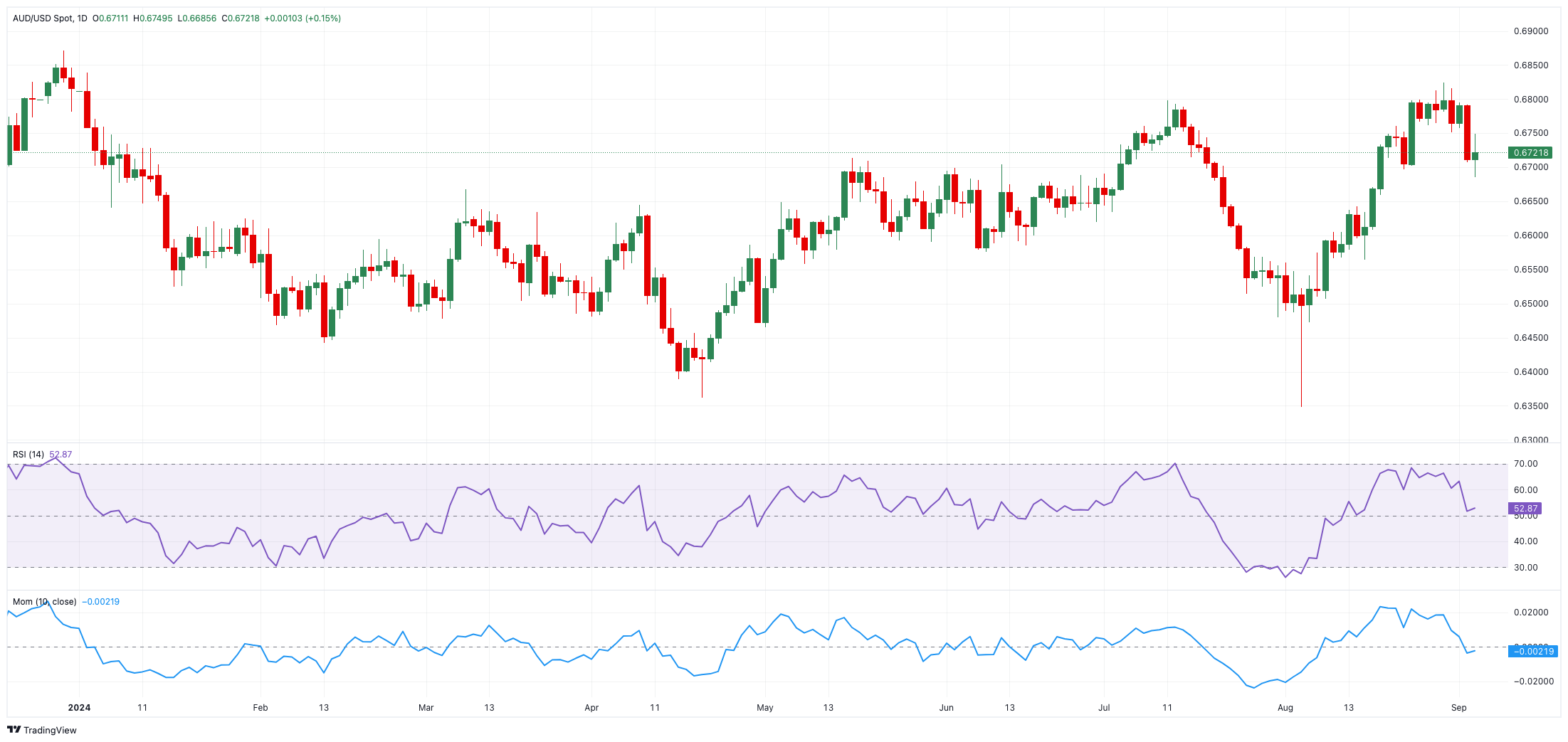- AUD/USD regained some balance following a breakdown of 0.6700.
- The Dollar faced renewed downside pressure following key job data.
- Australia’s GDP figures matched previous estimates in Q2.
The US Dollar (USD) reversed part of Tuesday’s gains on Wednesday, lending support to the risk-related assets and thus triggering a decent rebound in AUD/USD, which regained the 0.6750 zone following a brief drop to the sub-0.6700 region.
That said, the pair receded to two-week lows near 0.6680, just to regain composure afterwards following the U-turn in the Greenback and weaker yields worldwide.
In the meantime, the Australian Dollar maintained its constructive outlook, which remains underpinned by the critical 200-day SMA at 0.6615. This positive view on the Australian currency appeared jeopardized by the recent move higher in the US Dollar as well as persistent concerns surrounding China’s economic outlook.
The daily rebound in the pair was also accompanied by a slight decline in both copper prices, while iron ore future prices remained within a consolidative theme just above $90. The bearishness surrounding iron ore prices is likely to cap further gains in the AUD, while it is expected to keep lingering amidst the persistently weak economic activity in China.
Recent shifts in monetary policy have also supported the Australian dollar's upward trend over recent weeks. The Reserve Bank of Australia (RBA) recently opted to hold the Official Cash Rate (OCR) steady at 4.35%, adopting a cautious approach amid ongoing domestic inflationary pressures, with no clear indication of easing policy soon.
In a subsequent speech, Governor Michelle Bullock reaffirmed that the RBA is prepared to raise rates further if necessary to control inflation, maintaining a hawkish stance due to persistently high underlying inflation. She emphasized that the central bank remains vigilant about inflation risks even after deciding to keep rates unchanged.
Further optimism around the AUD was bolstered by the hawkish tone in the latest RBA Minutes, which revealed a debate among members about whether to raise the cash rate target. The minutes underscored persistent inflationary pressures and market expectations of possible rate cuts in late 2024.
Echoing the hawkish sentiment, RBA Deputy Governor Andrew Hauser noted earlier this week that there wasn't yet enough confidence that inflation in Australia was on a sustainable path back to target, indicating that rates would need to be kept steady for now.
However, a drop in the Melbourne Institute inflation gauge to a three-year low of 2.5% year-on-year in August suggests the possibility of a lower RBA cash rate by the end of the year.
The RBA is anticipated to be the last among G10 central banks to start cutting rates.
However, with potential rate cuts from the Fed in the near future and the RBA's likely prolonged period of restrictive policy, AUD/USD seems poised for further gains in the coming months.
Nevertheless, the Australian dollar’s gains could be constrained by the slow and gradual recovery of the Chinese economy. Deflation and inadequate stimulus are stalling China’s post-pandemic recovery. The last Politburo meeting, while expressing support, failed to announce any substantial new stimulus measures, deepening concerns about demand from the world's second-largest economy.
Meanwhile, the latest CFTC report for the week ending August 27 indicated that speculators remained net short on the AUD, although their positions were halved compared to the previous week. The AUD has been in net-short territory since Q2 2021, with only a brief two-week exception earlier this year.
On the data front, in Australia, the GDP Growth Rate figures showed the economy expanded by 0.2% QoQ in Q2 and 1.0% YoY.
AUD/USD daily chart
AUD/USD short-term technical outlook
Further increases are expected to push the AUD/USD to its August high of 0.6823 (August 29), followed by the December 2023 top of 0.6871 (December 28) and ultimately the 0.7000 level.
Bears, on the other side, may first pull the pair to the September low of 0.6685 (September 4) ahead of the temporary 55-day SMA of 0.6665, and the key 200-day SMA of 0.6615.
The four-hour chart sees a mild resumption of the upside bias. That said, the immediate resistance level is the 55-SMA at 0.6765, followed by 0.6823, which precedes 0.6871. On the other hand, the initial support level is 0.6685, followed by the 200-SMA at 0.664, and finally 0.6560. The RSI rose to nearly 42.
Information on these pages contains forward-looking statements that involve risks and uncertainties. Markets and instruments profiled on this page are for informational purposes only and should not in any way come across as a recommendation to buy or sell in these assets. You should do your own thorough research before making any investment decisions. FXStreet does not in any way guarantee that this information is free from mistakes, errors, or material misstatements. It also does not guarantee that this information is of a timely nature. Investing in Open Markets involves a great deal of risk, including the loss of all or a portion of your investment, as well as emotional distress. All risks, losses and costs associated with investing, including total loss of principal, are your responsibility. The views and opinions expressed in this article are those of the authors and do not necessarily reflect the official policy or position of FXStreet nor its advertisers. The author will not be held responsible for information that is found at the end of links posted on this page.
If not otherwise explicitly mentioned in the body of the article, at the time of writing, the author has no position in any stock mentioned in this article and no business relationship with any company mentioned. The author has not received compensation for writing this article, other than from FXStreet.
FXStreet and the author do not provide personalized recommendations. The author makes no representations as to the accuracy, completeness, or suitability of this information. FXStreet and the author will not be liable for any errors, omissions or any losses, injuries or damages arising from this information and its display or use. Errors and omissions excepted.
The author and FXStreet are not registered investment advisors and nothing in this article is intended to be investment advice.
Recommended Content
Editors’ Picks

AUD/USD: Further gains need more conviction
AUD/USD reversed two-daily pullbacks in a row on Tuesday, staging a decent comeback from Monday’s troughs near 0.6220 to the boundaries of the 0.6300 hurdle propped up by the RBA hawkish hold and firm data from Chinese business activity.

EUR/USD consolidates as traders holder their breath ahead of tariffs
EUR/USD stuck to familiar levels on Tuesday, churning chart paper close to the 1.0800 handle as investors brace for US President Donald Trump’s long-threatened “reciprocal” tariffs package, due to be announced on Wednesday at 1900 GMT.

Gold nears $3,100 as fears receded
Gold is easing from its fresh record high near $3,150 but remains well supported above the $3,100 mark. A generalised pullback in US yields is underpinning the yellow metal, as traders stay on the sidelines awaiting clarity on upcoming US tariff announcements.

US Government to conclude BTC, ETH, XRP, SOL, and ADA reserves audit next Saturday
Bitcoin price rose 3% on Tuesday, as MicroStrategy, Metaplanet and Tether all announced fresh BTC purchase. However, BTC price is likely to remain volatile ahead of the anticipated disclosure of U.S. government crypto holdings, which could fuel speculation in the coming days.

Is the US economy headed for a recession?
Leading economists say a recession is more likely than originally expected. With new tariffs set to be launched on April 2, investors and economists are growing more concerned about an economic slowdown or recession.

The Best brokers to trade EUR/USD
SPONSORED Discover the top brokers for trading EUR/USD in 2025. Our list features brokers with competitive spreads, fast execution, and powerful platforms. Whether you're a beginner or an expert, find the right partner to navigate the dynamic Forex market.
